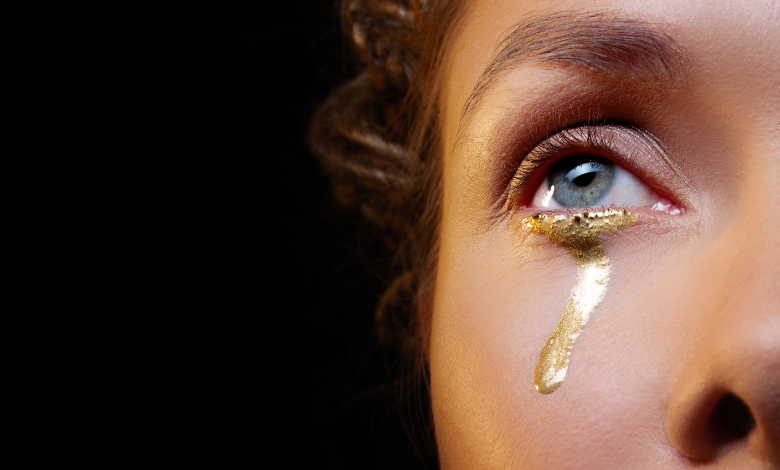What does it mean when you cry yellow tears? Learn the possible causes, why it happens, and when to seek medical advice.
I’ll never forget the first time I noticed something odd about my tears. I had just finished an intense work session, eyes tired from staring at my screen for hours in an effort to improve productivity. As I rubbed them, I felt an unusual stickiness. I grabbed a tissue and dabbed at the corner of my eye, only to find a faint yellowish stain. My mind immediately started racing, what in the world was going on?
If you’ve ever found yourself in a similar situation, you’re not alone. Crying yellow tears isn’t something most people talk about, but when it happens, it can feel downright alarming. So let’s break it down: what does it mean, why does it happen, and what should you do about it?
Article Breakdown
The Science of Tears: Why They Should Be Clear
Before diving into the specifics of yellow tears, let’s establish some basics. Normally, tears are composed of three layers:
- The Mucin Layer: This helps tears spread evenly across the surface of the eye.
- The Aqueous Layer: The watery part, responsible for keeping the eye hydrated and removing debris.
- The Lipid Layer: This prevents tears from evaporating too quickly.
When everything is functioning correctly, tears should be clear. Any change in color, whether yellow, green, or even reddish, suggests something unusual is happening.
Potential Causes of Yellow Tears
1. Eye Infections: When Bacteria Takes Over
One of the most common reasons for yellow tears is an eye infection. Ever woken up with your eyelids practically glued shut by crusty discharge? That’s a telltale sign of bacterial conjunctivitis, or pink eye. When bacteria infect the eye, they trigger an immune response, leading to:
- Swelling
- Redness
- Thick, yellow or greenish discharge
This discharge can mix with tears, causing them to appear yellowish. If you suspect an infection, it’s crucial to get checked out, some cases require antibiotic eye drops.
2. Blocked Tear Ducts: A Drainage Problem
Your tears don’t just sit in your eyes; they need to drain properly. When tear ducts become blocked, tears stagnate, allowing bacteria to thrive. This can lead to dacryocystitis, an infection of the tear sac, which produces:
- Yellow or white discharge
- Swollen, painful areas near the nose
- A constant feeling of eye watering
A simple warm compress can sometimes help open up the ducts, but if the issue persists, a doctor may need to intervene.
3. Blepharitis: The Hidden Culprit Behind Chronic Eye Irritation
Blepharitis is a condition many people suffer from without even realizing it. It’s essentially chronic inflammation of the eyelids, often caused by bacterial overgrowth or malfunctioning oil glands. Symptoms include:
- Red, irritated eyelids
- Flaky skin near the lashes
- Yellowish discharge, especially in the morning
Think of it like dandruff, but for your eyelids. Regularly cleaning your eyelids with warm water and baby shampoo can help manage symptoms.
4. Styes: The Pimple on Your Eyelid You Didn’t Ask For
A stye is essentially a blocked oil gland that gets infected, forming a painful, red lump. These can sometimes leak yellow pus, mixing with tears and causing them to take on a yellowish hue.
I once had a stye during an important work presentation. Not only did it make my eye look swollen, but the occasional leak of yellowish discharge made me constantly self-conscious. If you ever find yourself in this situation, applying a warm compress can help speed up healing.
When to See a Doctor
Not every case of yellow tears requires medical attention, but some definitely do. You should seek help if you experience:
- Persistent yellow discharge for more than a few days
- Severe pain or swelling
- Blurry vision
- Sensitivity to light
Your eyes are incredibly delicate, and ignoring symptoms could lead to complications.
Simple At-Home Remedies
1. Warm Compresses
A warm compress can work wonders, whether you’re dealing with a blocked tear duct, a stye, or general irritation. Simply soak a clean cloth in warm water, wring it out, and place it over your closed eyes for a few minutes.
2. Gentle Eyelid Cleaning
If blepharitis or an infection is the culprit, cleaning your eyelids is crucial. Use a mixture of warm water and baby shampoo, gently rubbing along the lash line with a cotton pad.
3. Artificial Tears
Sometimes, irritation alone can cause unusual tear coloration. Over-the-counter artificial tears can help flush out irritants and keep your eyes hydrated.
4. Avoid Contact Lenses & Makeup
While dealing with yellow tears, give your eyes a break. Contacts and makeup can introduce bacteria, making the issue worse.
Prevention: How to Keep Your Tears Crystal Clear
1. Maintain Good Eye Hygiene
Wash your hands before touching your eyes, replace eye makeup regularly, and clean contact lenses properly.
2. Stay Hydrated
Dehydration can thicken tears and make them more prone to irritation and infection.
3. Take Screen Breaks
Long hours of staring at screens can dry out the eyes, making them more susceptible to irritation and infections.
Key Takings:
- Crying yellow tears might not be something you ever expected to deal with, but if it happens, it’s your body’s way of sending you a message.
- Whether it’s an infection, a blocked tear duct, or simple irritation, the key is to address the root cause rather than just the symptom.
- Next time you notice something unusual about your tears, don’t panic.
- Take a moment to assess your symptoms, try some home remedies, and don’t hesitate to seek medical attention if necessary. Your eyes do a lot for you, it’s only fair to return the favor.
Useful Resources:
- What Causes Yellow Discharge From Eyes: This article explores the causes of yellow eye discharge, often linked to infections and other eye conditions.
- Eye Discharge: White vs. Yellow vs. Green: A detailed guide on the different colors of eye discharge, including yellow, and what they indicate about your eye health.
- Blocked Tear Duct – Symptoms and Treatment: Learn about blocked tear ducts, a common reason for yellow tears or discharge, and how they can be treated. Let me know if you need anything else.



